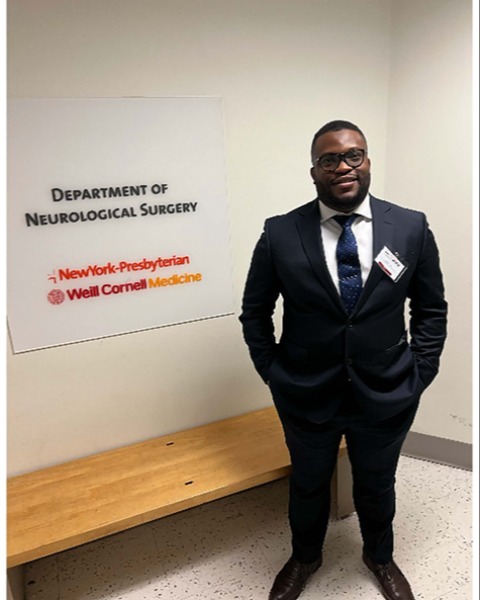Spine
Expandable Titanium Interbody Cages with Adjustable Height and Lordosis for Anterior Cervical Discectomy and Fusion: A Clinical and Radiological Study

Chibuikem A. Ikwuegbuenyi, MD
Research Fellow
Department of Neurological Surgery, Och Spine at NewYork-Presbyterian/Weill Cornell Medical Center, New York, NY, USA.
Presenting Author(s)
Introduction: Anterior cervical discectomy and fusion (ACDF) effectively treat degenerative disc disease. Inadequate restoration of cervical and segmental lordosis can result in higher rates of adjacent segmental disease (ASD) and revision surgeries. Despite its benefits, achieving optimal sagittal balance remains challenging with traditional static cages. This study assessed outcomes of ACDF using an expandable titanium cage with adjustable height and lordosis, focusing on pain, disability, sagittal alignment restoration, subsidence, fusion rates, and complications.
Methods: We conducted a retrospective, single-center study of consecutive patients who underwent ACDF using an expandable titanium cage with adjustable height and lordosis between September 2019 and May 2023. Clinical and radiological outcomes were assessed. Fusion was defined as < 1 mm of motion between spinous processes on dynamic X-rays, while subsidence was identified as a change of ≥2 mm in intervertebral height between immediate post-op and follow-up. Statistical comparisons across time points were performed using the Wilcoxon Signed Rank Test or paired t-test. Logistic regression was used to examine the association between the subsidence rate and the year of surgery.
Results: A total of 44 patients with 77 treated levels were analyzed (median follow-up: 12 months). The most treated level was C5-6 (39%), with most undergoing two-level fusions (61.4%). Median NRS-Arm pain decreased from 2 to 0 (p=0.025), NRS-Neck pain from 6 to 2 (p < 0.001), and ODI scores from 35 to 9 (p=0.031). Radiographically, cervical lordosis improved from 4.4° to 9.0° postoperatively (p < 0.001), maintained at follow-up. Segmental lordosis increased from -0.9° to 2.4° (p < 0.001). Anterior disc height increased from 4.0mm to 8.5mm (p < 0.001). The fusion rate was 89.6%, with subsidence in 20.8% of segments. Subsidence rates decreased significantly from 40% in 2019 to 0% by 2023 (p=0.044). No revision surgeries or neurosurgical complications occurred.
Conclusion : Our findings highlight the effectiveness of this expandable cage in correcting cervical sagittal alignment, increasing disc height, and increasing lordosis at the treated level. Clinical and radiologic outcomes improved, suggesting these cages may optimize ACDF procedures.
Methods: We conducted a retrospective, single-center study of consecutive patients who underwent ACDF using an expandable titanium cage with adjustable height and lordosis between September 2019 and May 2023. Clinical and radiological outcomes were assessed. Fusion was defined as < 1 mm of motion between spinous processes on dynamic X-rays, while subsidence was identified as a change of ≥2 mm in intervertebral height between immediate post-op and follow-up. Statistical comparisons across time points were performed using the Wilcoxon Signed Rank Test or paired t-test. Logistic regression was used to examine the association between the subsidence rate and the year of surgery.
Results: A total of 44 patients with 77 treated levels were analyzed (median follow-up: 12 months). The most treated level was C5-6 (39%), with most undergoing two-level fusions (61.4%). Median NRS-Arm pain decreased from 2 to 0 (p=0.025), NRS-Neck pain from 6 to 2 (p < 0.001), and ODI scores from 35 to 9 (p=0.031). Radiographically, cervical lordosis improved from 4.4° to 9.0° postoperatively (p < 0.001), maintained at follow-up. Segmental lordosis increased from -0.9° to 2.4° (p < 0.001). Anterior disc height increased from 4.0mm to 8.5mm (p < 0.001). The fusion rate was 89.6%, with subsidence in 20.8% of segments. Subsidence rates decreased significantly from 40% in 2019 to 0% by 2023 (p=0.044). No revision surgeries or neurosurgical complications occurred.
Conclusion : Our findings highlight the effectiveness of this expandable cage in correcting cervical sagittal alignment, increasing disc height, and increasing lordosis at the treated level. Clinical and radiologic outcomes improved, suggesting these cages may optimize ACDF procedures.

.jpg)